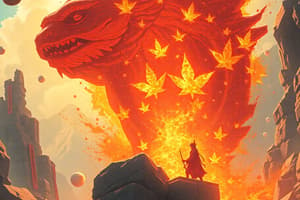Podcast
Questions and Answers
B-Roll footage is primarily used to establish the main storyline of a scene.
B-Roll footage is primarily used to establish the main storyline of a scene.
False (B)
B-Roll footage is always filmed in a cinematic style.
B-Roll footage is always filmed in a cinematic style.
False (B)
Green screen or chroma keying is never used in conjunction with B-Roll footage.
Green screen or chroma keying is never used in conjunction with B-Roll footage.
False (B)
B-Roll footage is only used in fiction films and documentaries.
B-Roll footage is only used in fiction films and documentaries.
Talking head footage is a type of B-Roll footage.
Talking head footage is a type of B-Roll footage.
Archival footage is a type of B-Roll footage.
Archival footage is a type of B-Roll footage.
B-Roll footage is used to create a sense of continuity between different scenes.
B-Roll footage is used to create a sense of continuity between different scenes.
Cinéma vérité is a style of B-Roll footage used in documentary making.
Cinéma vérité is a style of B-Roll footage used in documentary making.
Flashcards are hidden until you start studying
Study Notes
B-Roll in Filmmaking
- Supplementary footage that adds context and visual interest to a scene
- Used to:
- Establish a setting or atmosphere
- Provide cutaways to break up dialogue or action
- Add texture and depth to a scene
- Create a sense of continuity
- Often filmed in a more observational or documentary style
- Can include footage of:
- Landscapes or cityscapes
- People engaging in everyday activities
- Objects or props related to the scene
- Close-ups of textures or details
B-Roll as Background Footage
- Used to create a sense of realism and authenticity
- Can be used to:
- Set the tone or mood for a scene
- Provide a sense of location or setting
- Add visual interest to a scene
- Often used in conjunction with green screen or chroma keying
- Can be used in a variety of genres, including:
- Fiction films
- Documentaries
- Commercials
- Corporate videos
B-Roll in Video Production
- Used to add variety and visual interest to a video
- Can be used to:
- Break up talking head footage
- Add context and depth to a scene
- Create a sense of continuity
- Often used in:
- Interviews and testimonials
- Explainer videos
- Corporate videos
- Social media content
- Can be filmed in a variety of styles, including:
- Cinematic
- Documentary
- Observational
B-Roll in Documentary Making
- Used to:
- Add context and depth to a documentary
- Provide visual interest and variety
- Create a sense of atmosphere and tone
- Often used to:
- Establish a setting or location
- Show the passage of time
- Highlight specific details or objects
- Can be used in conjunction with:
- Interviews
- Voiceovers
- Archival footage
- Can be filmed in a variety of styles, including:
- Cinéma vérité
- Observational
- Expository
B-Roll in Filmmaking
- B-Roll is supplementary footage that adds context and visual interest to a scene
- It is used to establish a setting or atmosphere, provide cutaways to break up dialogue or action, add texture and depth to a scene, and create a sense of continuity
- B-Roll is often filmed in a more observational or documentary style
- It can include footage of landscapes or cityscapes, people engaging in everyday activities, objects or props related to the scene, and close-ups of textures or details
B-Roll as Background Footage
- B-Roll is used to create a sense of realism and authenticity
- It sets the tone or mood for a scene, provides a sense of location or setting, and adds visual interest
- B-Roll is often used in conjunction with green screen or chroma keying
- It can be used in a variety of genres, including fiction films, documentaries, commercials, and corporate videos
B-Roll in Video Production
- B-Roll is used to add variety and visual interest to a video
- It breaks up talking head footage, adds context and depth to a scene, and creates a sense of continuity
- B-Roll is often used in interviews and testimonials, explainer videos, corporate videos, and social media content
- It can be filmed in a variety of styles, including cinematic, documentary, and observational
B-Roll in Documentary Making
- B-Roll is used to add context and depth to a documentary
- It provides visual interest and variety, and creates a sense of atmosphere and tone
- B-Roll is used to establish a setting or location, show the passage of time, and highlight specific details or objects
- It can be used in conjunction with interviews, voiceovers, and archival footage
- B-Roll can be filmed in a variety of styles, including cinéma vérité, observational, and expository
Studying That Suits You
Use AI to generate personalized quizzes and flashcards to suit your learning preferences.




